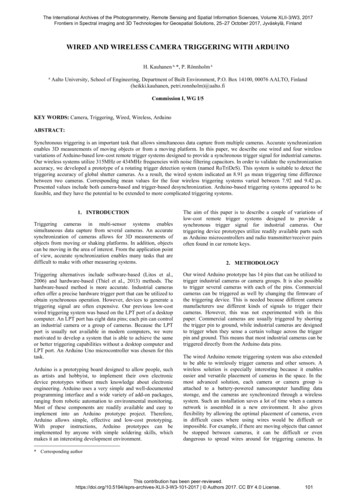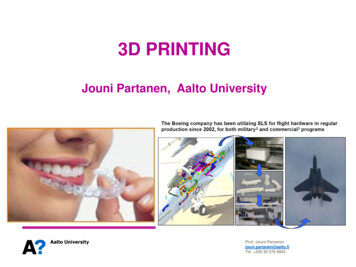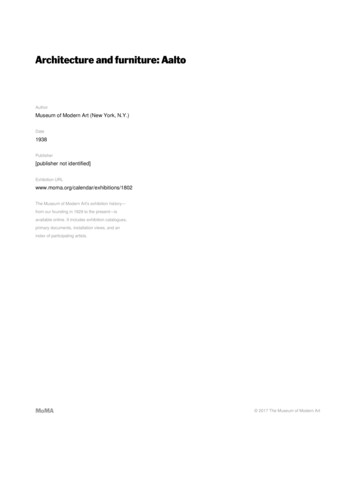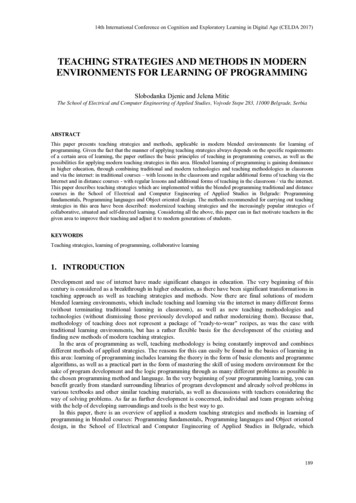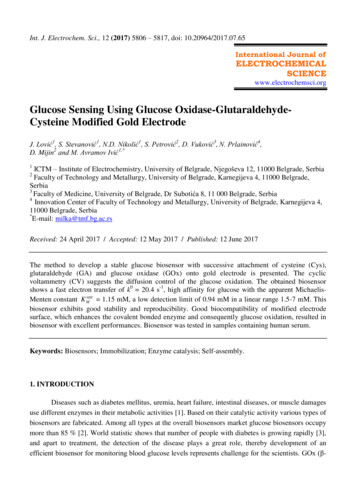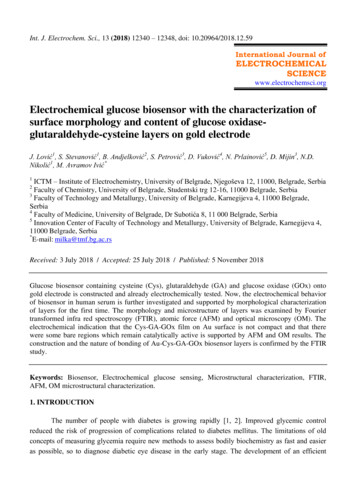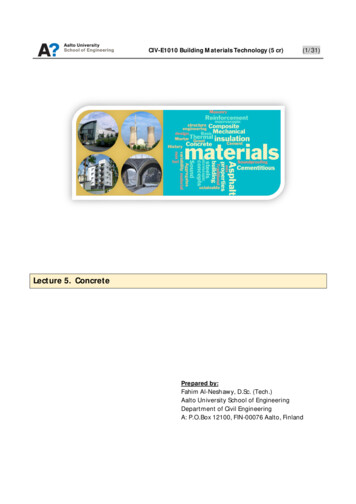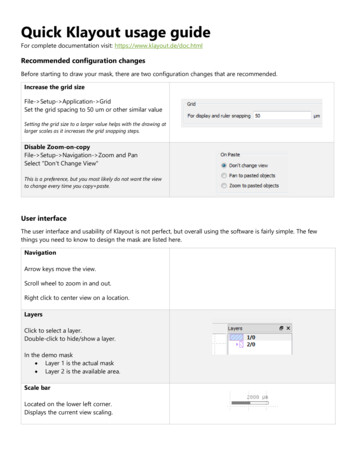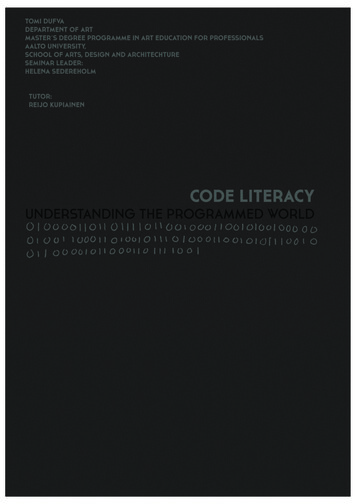
Transcription
!Aalto-yliopisto, PL 11000, 00076 AALTOwww.aalto.fiTaiteen maisterin opinnäytteen tiivistelmä!Tekijä Tomi DufvaTyön nimi Code Literacy. Understanding the programmed worldLaitos Taiteen LaitosKoulutusohjelma Kuvataidekasvatus MuuntokoulutusVuosi 2013Sivumäärä 90Kieli EnglantiAbstractMy study takes a look at digital technologies and the ways they are affecting our lives. The mainpremise in my study is that we need basic understanding about digital technologies in order to bein control of them. Digital technologies differ from analogue technologies in that they are alwaysprogrammed. We are left in unequal position where we are divided between those who can program and those who can’t.My study is a theoretical study and is in five parts. In the first part I cover some of the most basicideas in programming: binary systems, programming languages and basic components of computers. In the second part I take a look at some biases that affect how we use computers. Third partfocuses more on the cultural background and some ideologies concerning programming and digital technologies. In the fourth part I offer some insights into digital technology and conclude mystudy. Fifth part of my study is a separate book that offers practical tips for schools, both for teachers and students to learn programming and in understanding the core concepts of digital technologies. The fifth part is written in Finnish.Main sources in my study were: Carr, Nicholas: The Shallows: What the Internet Is Doing to OurBrains, 2011, Ceruzzi, Paul E.: Computing: A concise history, 2012 Lanier, Jaron: You are not agadget, 2010, Petzold, Charles: Code, The hidden language of computer Hardware and Software,2009, Rushkoff, Douglas : Program or be programmed, ten commandments for digital age, Steiner, Christopher: Automate this and Turkle, Sherry : Alone Together:Why We Expect More fromTechnology and Less from Each Other, 2011. Although many other sources were used in order toreach more extensive understanding of the subject.One of the main challenges in my study was in composing general overview of large and complicated subject matter. This naturally is essential in my study as one of the study’s goals is to democratise digital technologies by bringing general understanding of digital technologies to everyone.My main conclusion in this study is that we digital technologies are changing our world rapidly.Digital technologies are part of our everyday life, our digital self, or virtual extensions of our body.Because of this we do need to be code literate in order to gain control of ourselves in digital realm.Avainsanat code literacy, media literacy, programming, digital technologies!
Tomi DufvaDepartment of artMaster s Degree Programme in ArtEducation for professionalsAalto University,School of Arts, Design and ArchitechtureSeminar leader:Helena SereholmTutor:Reijo KupiainenCode literacy. Understanding the programmed worldby Tomi Dufva31 300 words
Prologue31. What is Programming1.1 A very concise history of computers1.2 Binary1.3 Logic1.4 Algorithms1.5 Programming languages1.6 Operating Systems1.7 Inside of computer1.8 Planting a tree78131620242628312. Programming biases.2.1 Time2.2 Choice2.3 Complexity2.4 Scale2.5 Social2.6 Lock in333438414449543. Ideological and cultural influences3.1 Programmers World3.2 Free Software3.3 Artificial intelligence3.4 Our relationship with technology57586167764. Conclusion85EndnotesBibliographyAppendix A98931012
Prologue:In our world, many of our actions are made through programs of some sort. Ihave written this paper with the aid of several programs and with differentdevices: I have my laptop for writing, a tablet for reading and researching anda smartphone in my pocket which allows me to quickly jot down notes, searchfor material or access my files. In fact an increasing number of theconnections we make to the outside world are through programs: We handlebanking online, we buy flight tickets online, and we also conduct our socialcorrespondence online through social media sites, email, video calls etc. Wesearch for information, and consume this information together withentertainment, all from our personal computer. In addition to this, programsare also involved when we do our grocery shopping at the supermarket. Webuy with our credit card, take money from an ATM, use our bus card forpublic transport, buy train tickets, drive our cars, wash dishes, wash laundry,use our kitchen appliances and much more. All these activities rely, to someextent, on digital programs, some of which have microchips embedded inthem.Much has been written about our use of programs and digital media as wellas the internet and all of its creations. There are books, blog posts, videos,articles for and against digital technology and dozens of guides for usingdifferent programs effectively. Lately, we have also had more ethical guidesconcerning the use of social media, again with enthusiastic and skepticundertones. However, there is far less written about the underlying base layerof the different programs we use on a daily basis, nor is there much talk aboutthe front-end of programs, i.e. the interfaces we use to interact with theprograms. We are so entangled in the medium's content that we fail toconsider the medium itself. Nicholas Carr references famous media theoristMarshall McLuhan's idea of "Media is the Message". In his book TheShallows he states that:".In the long run a medium's content matters less than the medium itself ininfluencing how we think and act. As our window onto the world, and ontoourselves, a popular medium molds what we see and how we see it. -And3
eventually, if we use it enough, it changes who we are, as individuals and as asociety." (Carr 2011, Prologue, paragraph 4)What McLuhan means is that the digital medium represents a windowleading to the digital content and our vision and perspective are significantlydefined by it. Look through small and dirty windows and you start to see theworld as foggy and dark, but look through a large open window and the viewitself looks different. Look through the latter window long enough and youstart to take the view for granted without questioning why the window is howit is, or could it be different in the first place. This has become even moreimportant in our age, as the use of programs is now weaved into our everydaylife; we actually know little about the medium itself: the language and logicbehind these programs. This is not to say that we should all be programmersand develop programs ourselves, but rather that it is important to be able toread and comprehend the base ideology of programs. It is only in this waythat we can assess how these programs are made to serve us, and do theyactually serve us in the way we think or hope they do.Douglas Rushkoff sums up the situation regarding why we should knowabout programs. Indeed, during an interview in Montys outlook blog hestates the following (Healey, 2012):Isn't that like asking everyone who drives a car to also know how to be an automechanic? Why can't we just be drivers instead ofmechanics?I'm happy for us to be drivers, but we're not. I'm not talking about a distinctionbetween mechanic and driver, where the user is supposed to know how to take aparthis laptop and replace the power supply or the RAM.I'm talking about the difference between a driver and a passenger. The passengeris not the true user of the car. If the passenger knows nothing about the car or howit works, he must depend completely on the driver for his reality. Is there asupermarket near here? Where are you taking me?The user with no programming knowledge at all may as well be sitting in theback seat of the car, with curtains covering the windows – or video screens in placeof the windows. He may be going to the best places in the best ways, or he may not.4
He has to trust his driver.I don't trust the drivers of our software and websites any more than I trusted thepeople making game shows and commercials for TV. I'm sure they're nice people,but I don't believe they all have my best interests at heart.I think at least some of them are more interested in making money for theircorporation than they are in serving me or my potential as a human being. I hopethat doesn't sound outrageously cynical. But I think most readers would have toagree that at least a few of the many companies out there are thinking of profitover humanity.And if that's true, then we might want to be in a situation where we have somecapacity to gauge whether the programs we are using to express ourselves, engagewith others, and make a living are working on our behalf. (Healey, Tim: TimHealey interviews Douglas Rushkoff: Little Grey Cells #6. People don't realiseFacebook is all about monetising social graphs, 2012, http://www.mob76outlook.com/little-grey-cells-6/ Site Visited: 10 02, 2013)Learning to read programs is not the same as learning to read programminglanguage. Indeed, whilst the latter may be helpful, it is not necessary. Instead,the ability which I call code literacy1 could be divided into three differentsections. First is the section designed to understand the concept of howprograms are built, and the core concepts of programming languages. Thesecond section aims to highlight the limitations of programs and digitaltechnology in general. The third section is concerned with developing someunderstanding of programming in a wider context.As previously mentioned, digital technologies are used in many areas of ourdaily lives and in the world in general. This spans from manufacturing anddistributing products, to neurosurgeries and space missions. In a similar way,research on digital technologies reaches into many areas, from thetechnological benefits of different computer languages and the history oftechnology, to neuroscience and artificial intelligence. It would be impossiblefor me to cover all of these areas in one study. Instead, I aim to providedifferent examples and insights into these different areas whilst at the same5
time I hope to define code literacy and reveal the need for it. In some sectionsI have intentionally made certain generalisations, such as with regards to thehistory of computers or in the chapters concerning programming languages. Ithink it is important to know the big picture and to not get bogged down bypondering the tiny details, such as who invented the first computer etc.This study is split into four sections. In the first section I take a look at thecore concepts of programming in order to give a general overview of howprograms are made. In the second section I describe some of the biases andlimitations of programming and other problematic tendencies related toprogramming. Following this, in the third section I offer some trails to look atdigital technologies in different contexts. In the fourth section I aim to gatherthese views together and evaluate the importance of code literacy ineducation and in society in general: What is it that we can do to be aware andact aware in the age of programmed environments. How we can be drivers inthe world of programs.The plus one section is even more practical and represents a separate sectionwhereby I use the my findings from the study to create pamphlets forteachers to use in schools. The aim of this pamphlet is to raise people'sawareness of programmed worlds, to teach some programming basicsthrough games and physical activities, and to give pointers for discussionsregarding various points made in the thesis. This part is separate and will bewritten in Finnish.6
1. What is programming?What do we talk about when we talk about programming computers?Programming is sometimes seen as a mysterious activity involving weird quietgeniuses who can break into any system with a few clicks, alter the course ofa satellite, or launch nuclear missiles, etc. However, in reality programming isnothing like that. If we want to look at analogues for programming, then wemust forget the caricatures which we get from action movies and have a lookat cooking. In short, programming can be understood as a set of instructionsfed to a machine (computer) which then executes these instructions. Indeed,this is much the same as following a recipe when cooking. A program is arecipe we write for a computer, which then executes those commands to(hopefully) achieve the desired result. Programming is a language which actsas an intermediary between humans and machines. Programming language isalso used, so that others can read the recipe and understand how the programworks. Programming languages is very different to natural languages.Programming language works between a human, a living being and acomputer, the latter of which is essentially just a block of silicon and othermaterials. Because of this, programming languages are written based on thelimitations of computers. The language must be exact, otherwise computersdo not understand us and nothing gets done. With natural language, we canusually guess what the other is saying even if that language is not thespeaker's native language.7
1.1 A very concise history of computers.The history of programming is extremely vast and can certainly not bethoroughly explored here. However, knowing just a little about the history ofcomputers and programming can help to understand and evaluate how andwhy programs are the way they are today.Computers and programming share a lot of history together, and when wetalk about programming we usually understand that it has something to dowith a computer. In this short overview I will simply point out some of theevents which have occurred during the history of computers. I do this in thehope that it might offer an insight into this vast world. In the later chapters Iwill focus more on some of the important inventions which have ledprogramming languages to their present day status. Here I will focus more onthe inventions which have led to the general use of computers which we seetoday. To put this in more computer-friendly terms, this chapter deals mostlywith computer hardware's history whilst the later chapters focus more on thehistory of software.The first use of computers was to aid in calculation. In this sense, the firstcomputational device was probably a tally stick, which is an elongated stickmade out of wood, bone or other hard material, and which contains a systemof marks. It is believed that some of these sticks were used as a calculation aidwhich would have been helpful in trading and to keep track of moon phasesamongst other things. The earliest forms of tally sticks are over 35 000 yearsold (Houghton, 2012, A Brief Timeline in the History of Computers). Tallysticks represent a key feature of computers: storing and retrieving data. If weadd that to its ability to automate and process calculations before outputtingthat data, we have the modern day computer. However, to reach this pointhas taken thousands of years.First it is important to note that more complex machines known as analoguecomputers can be found from ancient and medieval times. One of the first, orperhaps the very first, is the Antikythera machine from ancient Greece. This8
machine was discovered on a shipwreck in 1901. The Antikythera machinewas created approximately150-50 BC and has highly complex gear systemswhich have perplexed researchers ever since. It is only recently thatresearchers' effort has paid off. They have been able to conclude that themachine was a highly sophisticated astronomical clock which determined thepositions of celestial bodies with extraordinary precision.2 The term ‘analoguecomputer' is used when the machine uses continuously changing aspects ofphysical phenomena to model the problem being solved. In the Antikytheramachine it was the gear system which was used to model planet positions.However, later hydraulic or electrical systems were used. This makes themachines very different from digital systems. Indeed, instead of usingcontinuously changing aspects of physical phenomena, digital systems use anumerical binary system to model the problem in a symbolic way (Houghton,2012, A Brief Timeline in the History of Computers). In the AntikytheraMechanism Research Project: Project Overview, 2013, analogue computerswere used up until the 1960s or even up until the 1970s. This was despite thefact that the first digital machines were invented in the 1930s. (Ceruzzi, 2012,Chapter 1: The Components of computing)Much continued to happen during the era of analogue computers, Machinesfirst learnt to add or subtract, after which time machines which could bothadd and subtract were invented. Following this came the introduction ofmachines which could divide and multiply. Many famous scientists havecontributed to computers. Indeed, Blaise Pascal invented the first mechanicalcalculator in 1645, known as the Pascaline. The introduction of the Pascalinewas followed by the addition of direct multiplication and division in 1672,thanks to Leibniz. (Houghton, 2012, A Brief Timeline in the History ofComputers, Steiner, 2012, The Godfather of Modern Algorithm) Much of thehistory of computers is in fact calculator history. These calculators wereoperated by hand and the persons using them were called computers.Nevertheless, these machines took away the need for repetitive calculations asthey could be outsourced to machines.The next breakthrough for computers came in 1801when Josep-Marie9
Jacquard developed a loom, the pattern of which could be changed andcontrolled by punch cards, and large cards with holes. This introduced newpossibilities for programming. In 1833, Charles Babbage began working onhis analytical engine, a machine which used punch cards for data storage. Hisproject failed due to many reasons, such as the difficulty faced whenattempting to produce quality parts with the technology at the time. However,this was also due to Babbage's apparently difficult nature. Punched datastorage was introduced in the 1880s by Herman Hollerith who together withdata storage invented methods with which to produce punch cards and waysin which machines could read them. His company eventually became the coreof IBM. Punch cards were used for almost 100 years and offered new fieldsfor computers as they could move from simple calculations to more complexdifferential equations. (Ceruzzi, 2012, Chapter 1, The Components ofComputing)Alongside scientific purposes, the driving forces behind the development ofmore sophisticated computers were finance and wars. Ever since the tallystick, computers have been used to calculate loans, debts, pay checks etc.When the machines started to become more complex, the war industrystarted to show interest. The era of digital computers began around the timeof World War II. Having machines that could for example calculate thetrajectories of weapons was crucial in winning the war. There is oneparticular famous example of the importance of computers from World WarII. A Nazi scientist had developed a cryptographic machine, called theEnigma, which they believed was uncrackable. The Nazis encrypted all theirwar correspondence, tactics, strategies etc. with the Enigma machine. Thismade it very hard for the allies to spy and gather Intel from the enemy. AlanTuring, an English mathematician, led a team which was eventually able tocrack the Enigma's encryption using sophisticated machines andprogramming. Later in the war, Turing helped to crack the Nazis' otherencryption methods and helped to build one of the first digital computers, theColossus, which was used in the encryption processes. The Colossus was ahuge computer and amazingly fast for the time. Of course, if we compare it toour modern computers, the processor's speed is only 5.8MHz, (megahertz)10
whilst even our smartphones run at over 1Ghz (gigahertz) (Ceruzzi, 2012,Chapter 2, The Advent of Electronics).Following the end of the war, computer development progressed rapidly andis in fact still progressing. Even in 1945, the United States built ENIAC(Electronic Numerical Integrator and Computer) a first general purposecomputer, which could be used in many fields.3 (Ceruzzi, 2012, Chapter 2,The ENIAC) Computers quickly became products and useful tools for bigindustries. In 1952, IBM introduced the first commercial computers.Following this, 1954 saw the introduction of more "affordable" computerssuch as the IBM 650, which weighed over 900 kg whilst its power supplyweighed an additional 1350kg. The IBM 650 cost 500 000 4 at the time(IBM, 2013). IBM also introduced the first hard disks; large metal diskswhich at the time cost 50 000 5 (Maleval, 2011, First HDD at 55 From IBMat 100). This first generation of computers were quickly replaced by secondgeneration computers with more advanced electronic parts, such astransistors. They were also smaller, cheaper and consumed less electricitythan the second generation, whilst the third generation had already arrivedby the 1960s. First and second generation machines were still largecomputers, and not something you would want to keep in your own home,unless you had a nice large spare hall and lot of electricity. Third generationcomputers' electronic circuits shrank in size considerably whilst the firstmodern microprocessor was introduced by Intel (Ceruzzi, 2012, Chapter 5,The Microprocessor). In addition, the first home computers were made andas we know found their market in a ways no-one would have believed.“I think there's a world market for about 5 computers."(Thomas J. Watson, Chairman of the Board, IBM, circa 1948)“640K ought to be enough for anybody."(Bill Gates, 1981)6Until very recently, the evolution of computers had been fairly quick due tothe needs of the finance and war industries. Even now, many of theinventions presented to us in consumer electronic fairs emerged from certainlaboratories investigating new advanced military equipment. These inventions11
have transformed our everyday life, although the technology is developedbased on the needs and interests of those fields. Would we have computerswithout the rise of capitalism or wars? Would the computers work indifferent ways? These are interesting questions when evaluating the ways inwhich programs work.12
1.2 BinaryThere are 10 types of people in the world: Those who understandbinary, and those who don't.After the introduction of digital computers, which ran different programs, itwas necessary to find a way in which to program these machines. The veryfirst programming language used is called machine language (Petzold, 2009,Chapter 17. Automation) and this is still the only language which computerscan actually understand. Machine language is just a series of zeroes and ones.Machine language dates back to basic digital computers which had long rowsof switches, each representing a digital value: 0 or 1. Computers read theprogram from one switch to another switch and processed instructions basedon whether the switch was on or off. However, this is still the nature of all theprograms we use today. The number of switches has just increased, and infact we still use basic machine language programming everyday, whenswitching lights on or off or other electronic appliances: Other way it's on or 1in binary and the other way off, or 0.When the electronic components became speedier and more affordable, fastercomputers were built and programming by switching became slow and hardwork. Programming a computer already required many programmers, usuallywomen, to program new programs into the computer. Machine language hasa few apparent drawbacks: a series of switch states or zeroes and ones is verydifficult for humans to understand. It takes a long time to write andunderstand even the simplest of programs, not to mention our modernprograms, with millions of lines of zeroes and ones. As a result of this, newlanguages were invented, although a vast array of switches remains at theheart of every program. However, the switching is being done by lightningfast charges of electricity instead of women.I will not go into detail regarding how programming with binary is carriedout. That, in fact, depends on the machine used, as different kinds of13
machines have a different set of operations. With this said, it may be good tounderstand a little of how the binary system works, if for nothing else than tounderstand the joke in the topic of this chapter. Thus, the binary system isjust another calculating system. We usually use the decimal system, which isbased on ten digits, although other systems do exist too. One of these is thebinary system, which is based on just two digits. The binary system can betranslated into the decimal system, and the decimal system to the binary. This,in fact, is partly what is happening when we program with some higher-levelprogram language and send or compile in programming terms, the program tothe computer.When we use the decimal system we have ten digits, and thus we cancount to ten easily: 1, 2, 3, 4, 5, 6, 7, 8, 9, 10. However, see what happens withthe number 10. This can become even more transparent when we include 0and 11: 0, 1, 2, 3, 4, 5, 6, 7, 8, 9, 10, 11. When we run out of the ten digits we usethe method of adding a digit, in front: 10, 11, 12.20, 21, 22.60, 61, 62. Inbinary we use the same method. However, because we only have two digits,the numbers become increasingly long rows of 0s and 1s. In binary, 1 is 1, 2 is10, 3 is 11, 4 is 100. Moreover, 5 is 101, 6 is 110, 7 is 111, 8 is 1000, 9 is 1001and 10 is 1010. After 1, we no longer have numbers, and thus we mustsubstitute this by taking another number 10. This then happens again in 4as we have run out of every option with two numbers: 01, 10, 11, hence 4 is100. The logic behind this is the same as that behind our decimal system.Binary systems work in the exact same way, although they use the lessnatural system of 2 instead of the more familiar system of ten.7As an invention, binary is nothing new. The modern binary system8 wasformulated by Gottfried Leibniz in 1679. Leibniz was a polymath andcontributed to science in many ways. However, he also had a morephilosophical side, which is evident in his binary thinking. He thought thatevery action we make, be it a simple question or a longer thought process etc.can be simplified into a binary decision, a yes or a no. This can then berefined over and over again. This thinking offered many advancements inlogic and science, although for Leibniz the binary system was not only a14
mathematical system but also a philosophy. He saw that it could be used in allaspects of life, reducing complex problems to a set of simple yes and noquestions (Steiner, 2012, Godfather of Modern Algorithm). Christian Steinerwrites in his book Automate This: How algorithms came to rule our world:Gottfried Leibniz, like Isaac Newton, his contemporary, was a polymath. Hisknowledge and curiosity spanned the European continent and most of itsinteresting subjects. On philosophy, Leibniz said, there are two simple absolutes:God and nothingness. From these two, all other things come. How fitting, then,that Leibniz conceived of a calculating language defined by two and only twofigures: 0 and 1. (Steiner, 2012, Chapter 2, A Brief History of Man andAlgorithm, The Godfather of the Modern Algorithm, 1st paragraph)In his 1703 paper "Explanation of Binary Arithemic." (Steiner, 2012, TheGodfather of the Modern Algorithm) Leibniz defines his binary language. Inthis language, the numbers and arithmetic operations, dividing, adding,subtracting and multiplying are all presented in binary form. Around thesame time, Blaise Pascal had created a mechanical adding machine, whichcould perform simple adding calculations. Leibniz wanted to best him andcreated a machine which could perform all of the basic arithmetic functions.Unfortunately, when he presented it in Royal Society in London, the machinefailed and Leibniz lost interest in it. It was much later with the invention ofsemiconductors and electronics in the 1930s that Leibniz's binary systemwould show its brilliance9 (Steiner, 2012, Godfather of Modern Algorithm).Nowadays, binary systems are hidden inside the computer and are not reallysomething which we must often deal with. However, the nature of binarysystems, the simple yes or no, remains the basic nature of all digitaltechnologies and is inherently different from our real life analogue one.However, as stated in the beginning: There are 10 types of people in theworld: Those who understand binary, and those who don't.15
1.3 LogicNo, no, you're not thinking; you're just being logical. -NielsBohrLeibniz's binary system is not the only thing needed to create programs. Withbinary systems we can perform mathematical equations, although takingcomputers from mere calculators to the computers we use today meant thatprogramming needed a structure to bind different binary operations together.This general usefulness of programming comes largely from George Boole(Steiner, 2012, Boolean Logic Machines). In 1832, when Boole was justseventeen years old, he came up with the idea that human reasoning could bededucted to simple sentences and then combined together with a set ofmathematical expressions, such as "if", "or", "not", to form a language of logicor language of thought as he saw it (Steiner, 2012, Boolean Logic Machines).It is this logic which powers all of our programs today. You can only see youremail if you type your email address and password correctly. In addition, youcan type a lower case a on a keyboard if you press a, and can get an uppercase A if you press a and shift or have caps lock on. Boolean logic is also whatpowers our web searches: When we for example search for "funny catpictures" in a search engine, the search is carried out using the words funnyand cat and pictures. We can use these operators in our own search results toachieve more relevant results or to skim down our search.In 1854 Boole published his book
Nicholas Carr references famous media theorist Marshall McLuhan's idea of "Media is the Message". In his book The Shallows he states that: ".In the long run a medium's content matters less than the medium itself in influencing how
